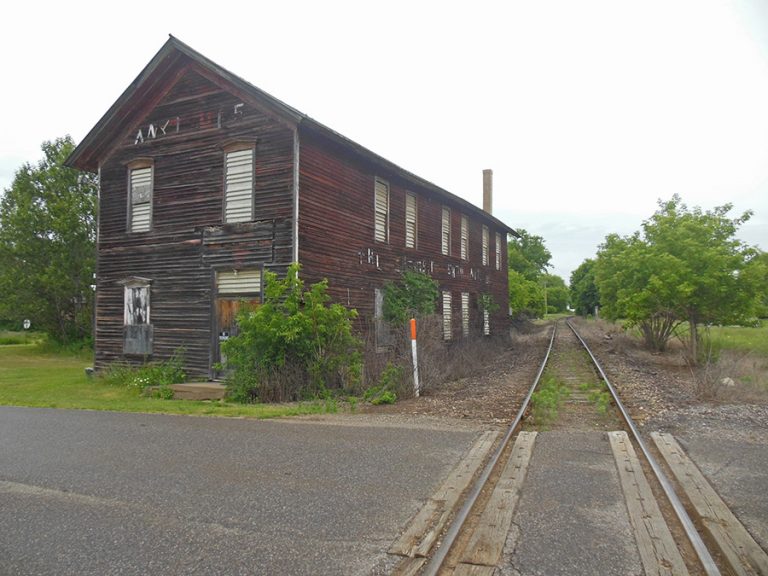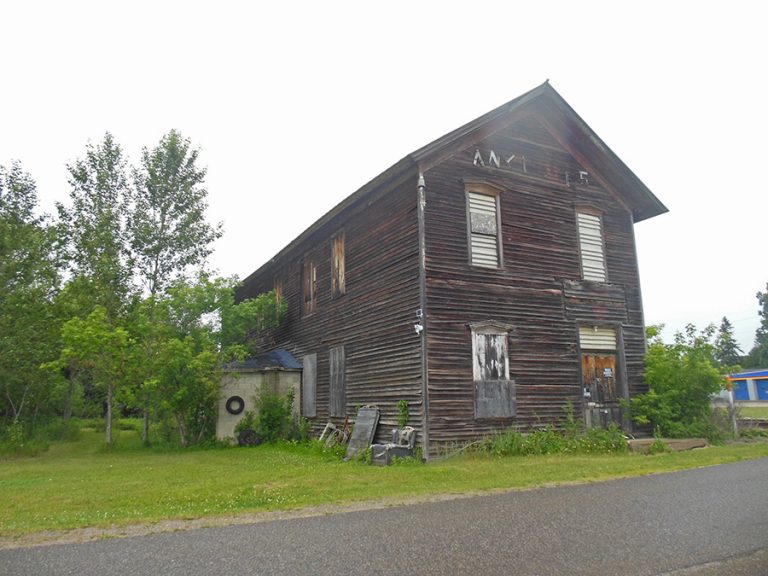Iron Ore at Iron Mountain, Mich.
One reason the Milwaukee & Northern (M&N) strove to reach Michigan’s Upper Peninsula was to obtain a share of the iron ore traffic. The M&N hauled ore from at least three of the mines at Iron Mountain, Mich., the Chapin Mine, the Hamilton Mine, and the Ludington Mine. All three were also served by the Chicago & North Western (C&NW). In addition to hauling out the iron ore, the railroads delivered large quantities of coal, lumber, stone, and other supplies to support mining operations.
The Hamilton Mine
The Hamilton Ore Co., from Sharon, Penn., discovered an iron ore deposit at Iron Mountain, Mich., in 1883. Development of the Hamilton Mine began almost immediately. The first ore was shipped in 1886, 872 tons. By the end of 1890, there were two shafts which had extracted 17,072 tons of ore that year. The total production for the first five years of operation was 35,692 tons of ore. In 1891 alone, 58,197 tons of iron ore were shipped.
The ore was shipped to the company’s mills at Sharon, Newcastle and Greenville, Penn., which produced sheet iron, bar iron, pig iron and nails.
On 1 January 1892, the Hamilton Mine and the adjacent Ludington Mine, owned by the Lumbermans Mining Co., flooded. The attempts to pump the water out of both mines failed, and they closed down. Several hundred miners were suddenly out of work.
The Chapin Mining Co., owners of the adjacent Chapin Mine, purchased the Hamilton Mine and Ludington Mine in 1895. They succeeded in pumping the water out and placing both mines back into operation.
The Oliver Iron Mining Co. purchased the Chapin Mining Co. in 1901. They closed the mines in 1932, some references state 1934.
Looking northeast along the E&LS, former MILW, main line from Hamilton Rd. at Iron Mountain, Mich., on 26 June 2021. This awesome, albeit haggard, structure is Miners’ Hall. It dates to at least 1891, when it was depicted on the Sanborn map, on 2nd St., between the Chapin Mining Co. office and Fire Engine House No. 2. The first floor was used as a dry house, a changing room and showers for the miners. The second floor was used for meetings of the miners’ union. Some references state that it was originally a boarding house. According to the Sanborn maps, the building was moved to its current location sometime between 1911 and 1923. The 1923 map lists it as a dry house. Its most recent occupant was the Curiosity Shop, an antique store. This is not the original right-of-way of the M&N main line. When the line was originally laid in 1887, the main line ran about 100′ to the west. The 1923 Sanborn map depicts this stretch of rail as a C&NW spur. Circa the 1930s or 1940s, the MILW rerouted their main line between Fleshiem St. and 6th St., probably to avoid the continued settling and flooding of the Chapin Pit. This grade crossing was called Miners’ Hall crossing on a C&NW time table from the 1990s. Their main line ran parallel to the right. Photograph by Tom Bruss.
This neat, old building stands along the E&LS, former MILW, main line at Hamilton Rd. at Iron Mountain, Mich., on 26 June 2021. This awesome, albeit haggard, structure is Miners’ Hall. It dates to at least 1891, when it was depicted on the Sanborn map, on 2nd St., between the Chapin Mining Co. office and Fire Engine House No. 2. The first floor was used as a dry house, a changing room and showers for the miners. The second floor was used for meetings of the miners’ union. Some references state that it was originally a boarding house. According to the Sanborn maps, the building was moved to its current location sometime between 1911 and 1923. The 1923 map lists it as a dry house. Its most recent occupant was the Curiosity Shop, an antique store. This is not the original right-of-way of the M&N main line. When the line was originally laid in 1887, the main line ran about 100′ to the west. The 1923 Sanborn map depicts this stretch of rail as a C&NW spur. Circa the 1930s or 1940s, the MILW rerouted their main line between Fleshiem St. and 6th St., probably to avoid the continued settling and flooding of the Chapin Pit. This grade crossing was called Miners’ Hall crossing on a C&NW time table from the 1990s. Their main line ran parallel to the right. Photograph by Tom Bruss.
This impressive, old, red sandstone structure is Engine House No. 2 of the Hamilton Mine at Iron Mountain, Mich., on 26 June 2021. It was built in 1891, to replace an earlier, smaller engine house for their Shaft No. 2. It is listed as Amazon Shaft No. 2 on the 1897 and 1904 Sanborn maps. That unusual moniker may be a reference to the fact that the new engines and hoisting equipment were claimed to be “the largest one shaft equipment of any in the world” when they were installed in 1891. The smaller, square red sandstone building right behind the engine house is an electric transformer house built sometime between 1904 and 1923 by the Oliver Iron Mining Co., which had purchased the Hamilton Mine in 1901. After the mine closed, these buildings were home to the Michigan Manufacturing Co. for many years. The tall smokestack in the background is the only remnant of a boiler house erected by the Oliver Iron Mining Co. sometime between 1904 and 1923. It replaced the 1891 boiler house which would have stood just out-of-frame to the left. M&N spurs ran along both sides of this building. The original right-of-way of the M&N main line, when the line was originally laid in 1887, would have run down the middle of this street. The current E&LS main line runs about 100′ to the east. Circa the 1930s or 1940s, the MILW rerouted their main line between Fleshiem St. and 6th St., probably to avoid the continued settling and flooding of the Chapin Pit. Photograph by Tom Bruss.



